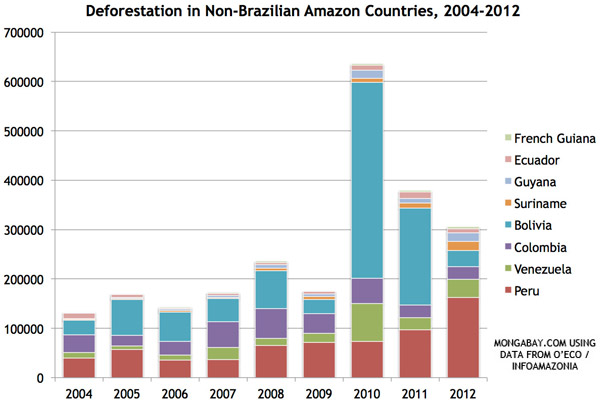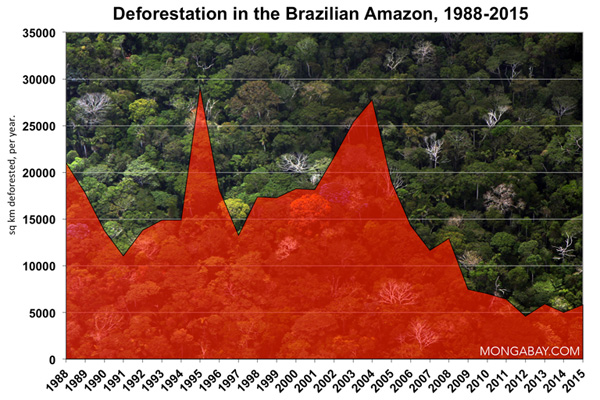The 28 percent increase in deforestation in the Brazilian Amazon over last year that was reported this week is bad news, but it is not surprising. It is bad news because the decline in deforestation since 2005 has given us the single largest contribution to climate change mitigation on the planet, far surpassing the reductions in emissions achieved by any Annex 1 country under the Kyoto Protocol [1]. Brazil’s achievement is particularly noteworthy because it did not come at the expense of agricultural production; beef and soybean production continued to grow [1, 2]. The increase in deforestation is not surprising because there are still no positive incentives flowing to the farmers and livestock growers whose collective land-use decision-making determines how much forest falls each year. There is time to correct this.
We review here some hypotheses for why deforestation increased and some thoughts on which hypotheses are the most plausible. Most are hypotheses that have been presented in the media and in the literature. Rigorous testing of these hypotheses will require further analysis.

Hypothesis 1: The new Forest Code in Brazil has given license to landholders to clear more forest
Response: Unlikely.
-
First, the new Forest Code does not reduce the amount of forests that landholders must keep on their properties. They still must keep at least 80 percent of their landholdings in forest if they are located in the Amazon region.
Second, there is a surprising lack of hard evidence that the Forest Code has inhibited deforestation in the past. Compliance has been very low, in part because the government did little to implement the Code. In Mato Grosso, less than 1/5th of landholders were in compliance with the Forest Code as of 2012 [3].
Could the amnesty afforded to landholders in the new Forest Code, reducing the area of land that they are required to reforest, have instilled in landholders a sense of impunity, encouraging them to clear more forest? Perhaps, but if that were the case, why didn’t they begin to assert their impunity last year, after the New Forest Code was approved?
Hypothesis 2: Rising commodity prices have increased the profitability of forest conversion to crops and livestock, increasing deforestation rates.
Response: Likely a significant factor, when combined with Hypothesis 3 below
First, soy prices were close to their all-time high in late 2012 and early 2013 and a somewhat weaker Real has favored exports. (Beef prices, corrected for inflation, have been flat.) Soybeans are not the biggest proximate driver of deforestation, but they are the most profitable large-scale Amazon land use. Of particular importance, high soybean prices drive up land values, capitalizing and displacing cattle ranchers who can then move deeper into the forest frontier [4].
Second, most of the Amazon is not suitable for soy. Only 3 percent of the Amazon is forested, suitable for soy and outside of protected areas [5]. Most of the potential for soy conversion is found in Mato Grosso, where deforestation rose 390 km2 (out of a total increase of 1,270 km2). Pará, where the biggest increase in forest clearing took place (640 km2, half of the total), has only limited potential for soy expansion.
Third, cattle intensification may be slowing down, making it more difficult to increase beef and crop production without forest clearing. (Cattle intensification—greater beef production per area of pasture—has been an important element of the decline in deforestation in the Brazilian Amazon region because it has allowed the cattle herd and soy production to grow with less clearing of new crop- and grazing-land [1, 2].)

Hypothesis 3: The “command-and-control” measures that have been implemented in the Amazon to reduce deforestation are reaching their limits. Farmers have yet to receive positive incentives for their roles in lowering deforestation.
Response: Probably quite important.
-
Although one would think that Brazil’s deep reduction in deforestation involved both positive and negative incentives to keep farmers and livestock producers from cutting down trees, this is actually not true. The incentives are virtually all negative (see Table below). Some programs designed to deliver positive incentives, such as REDD+, have not yet been implemented in a way that would send positive signals to responsible producers, beyond a few scattered projects mostly using non-market funds for payments (e.g., the Amazon Fund). (Review of this topic will be published in December 2013 [6]). With this lack of positive incentives for keeping forests standing, and perhaps a perception that law enforcement has declined, forest clearing associated with land speculation may have increased.
| Law/Initiative | Forest metric | Negative incentive | Positive incentive |
| Forest Code | 80% of property with forest cover | Fines, access to credit | None |
| Critical Municipalities | Municipality-wide deforestation | Access to credit and markets | None |
| Soy Moratorium (voluntary) | Cut-off date for forest clearing | Access to soy buyers | None |
| Beef Moratorium (voluntary) | Cut-off date for forest clearing | Access to beef buyers | None |
| Roundtable for Responsible Soy (RTRS), Voluntary; few farms certified | Restrictions on clearing native habitat | Uncertified producers may be shut out of some markets | Price premiums (although they have been very low) |
| REDD+ | State-wide, historical deforestation | None | Not yet implemented for farmers at scale |
| Consumer Goods Forum commitment | Zero net deforestation by 2020 | Exclusion from CGF buyers | None designed. |
| Low-Carbon Credit (ABC) Program | Legal compliance | Low interest (5.5%) credit; but uptake has been low |
Chart: Eight of the laws, programs and voluntary initiatives designed to slow deforestation that are operating in Mato Grosso, where most of the decline in deforestation has taken place. Virtually all of the incentives for farmers to keep forests standing have been negative (from ref 6).
Hypothesis 4: Agrarian reform farm settlements (“assentamentos”) are still without an effective alternative to deforestation
Response: Probably not a significant factor
The decline in deforestation has taken place primarily on medium and large-scale land holdings, which have been the focus of law enforcement activities and other negative incentives Smallholders tend to clear the same amount each year. Their capacity to clear land is limited by labor constraints. Their ability to respond to perceived national or international market opportunities is also low, since most of their production is for subsistence or local markets. Smallholder deforestation as a proportion of total deforestation in the Brazilian Amazon has increased, but we still don’t know if there have been substantial increases in the absolute area cleared by smallholders.

Another possible cause:
Infrastructure: Dam construction (Belo Monte) and improvements (both current and planned) in soy transport along the Tapajos River corridor may have increased forest clearing in Pará state. The second factor may be driving land speculation and forest clearing in northern Mato Grosso and western Pará. A hydro-electric complex on the Madeira River may have contributed to the rise in deforestation in Rondonia state.
Overall Response
The rise in deforestation is probably the result of several factors. There is no evidence that the New Forest Code is one of them. It is important to remember, as well, that the increase is small. Deforestation in 2012 was 77 percent lower than the ten year average ending in 2005; in 2013, it is 70 percent lower. The amount of deforestation recently reported is still the 2nd lowest since official monitoring began.
Keeping deforestation from rising further (reviewed in ref 6)
- Negotiate a shared definition of success in reducing deforestation among agricultural, livestock and finance sectors. The average historical rate of deforestation is already used as a performance baseline by REDD+ programs, Brazil’s National Climate Change Policy and the “Municipios Criticos” program, and is recommended here as a simple, robust metric.
- Align the Consumer Goods Forum 2020 “zero net deforestation” commitment, domestic agricultural credit programs, other financial instruments (such as the ICMS Verde recently implemented in Pará State), REDD finance (the Amazon Fund has been sitting on a proposal from Mato Grosso for two years), and other benefits, to favor the producers and local governments who are lowering deforestation across municipalities and entire states below its historical average. The volume of funding to finance deforestation is far greater than that targeted toward reducing deforestation. This ratio needs to be reduced or even inverted.
- Develop economic alternatives for smallholder families in agrarian reform settlements that do not depend upon further forest clearing. Provide smallholders with the extension services and infrastructure they need to invest in more intensive production systems that reduce pressure on forests.
- Ramp up support for indigenous peoples livelihoods. Their territories act as strong barriers to deforestation.
Authors
Daniel Nepstad, PhD
Executive Director
Contact: dnepstad [at] earthinnovation.org
David McGrath, PhD
Senior Scientist
João Shimada
Agricultural Commodities Lead
Claudia Stickler, PhD
Scientist
Earth Innovation Institute
CITATIONS:
- Nepstad, D. C., W. Boyd, C. M. Stickler, T. Bezerra, and A. A. Azevedo. 2013. Responding to climate change and the global land crisis: REDD+, market transformation and low-emissions rural development. Philosophical Transactions of the Royal Society B-Biological Sciences 368.
- Macedo, M. N., R. S. DeFries, D. C. Morton, C. M. Stickler, G. L. Galford, and Y. E. Shimabukuro. 2012. Decoupling of deforestation and soy production in the southern Amazon during the late 2000s. Proceedings of the National Academy of Sciences of the United States of America 109:1341-1346.
- Stickler, C. M., D. C. Nepstad, A. A. Azevedo, and D. G. McGrath. 2013. Defending public interests in private lands: compliance, costs and potential environmental consequences of the Brazilian Forest Code in Mato Grosso. Philosophical Transactions of the Royal Society B-Biological Sciences 368.
- Nepstad, D. C., C. M. Stickler, and O. T. Almeida. 2006. Globalization of the Amazon soy and beef industries: opportunities for conservation. Conservation Biology 20:1595-1603.
- Nepstad, D. C., C. M. Stickler, B. S. Soares Filho, and F. Merry. 2008. Interactions among Amazon land use, forests and climate: prospects for a near-term forest tipping point. Philosophical Transactions of the Royal Society 363:1737-1746
- Nepstad, D., S. Irawan, T. Bezerra, et al. in press. More food, more forests, fewer emissions, better livelihoods. Carbon Management
